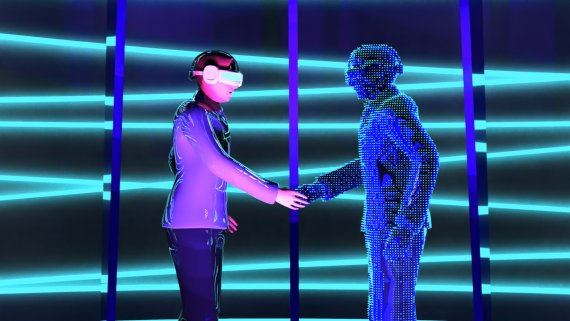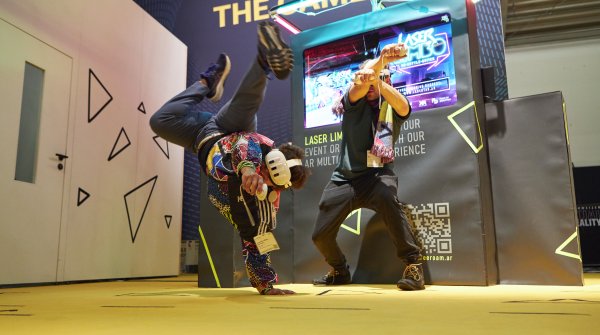
In order to understand the impact the Metaverse will have on sports, one must first understand what the Metaverse is in the first place. Because after Facebook's admittedly clever move to name itself after the Metaverse, there is a lot of confusion about the actual background and technology. It is important to know that the Meta Group is not the Metaverse and never will be.
What is clear, however, is that the Meta Corporation will be a major player in the Metaverse. Maybe even the biggest. Zuckerberg laid the foundation for this early on. Back in 2014, Facebook acquired the virtual reality company Oculus. So the work in the area of the Metaverse has long since begun. The rebranding merely brought this to the fore.
However, the term metaverse itself is much older. It was coined as early as 1992, in a novel by Neal Stephenson called "Snow Crash". In this novel, the metaverse is described as a virtual 3D world that you can enter with the help of a personal terminal and special glasses.
The connection between Metaverse and sports presents unprecendet opportunities. From immersive fan experiences to virtual events and sponsorship opportunities. Companies that embrace this technology at an early stage can position themselves as pioneers in a rapidly evolving digital sports landscape.
This virtual reality from Stephenson's novel appears to the user as a city created along a single street a hundred meters wide. As in the real world, Neal Stephenson's Metaverse is built and developed so that the virtual world continues to evolve. Users can build their own streets and buildings, as well as create signs, parks, and even new things that don't exist in our reality. Gigantic light spectacles or oversized buildings and areas in which the laws of physics as we know them seem to be suspended.
Sound familiar? Not surprisingly. Because what Neal Stephenson described in his novel more than 30 years ago has long since become reality today. These virtual spaces have long since become reality in the form of platforms and immersive gaming worlds such as Second Life, Minecraft or World of Warcraft. Sometimes more and sometimes less based on our real reality.
This concept offers enormous potential for the sports industry. The metaverse offers completely new opportunities for fan engagement, sponsorship and event staging. Virtual stadiums, personalized training rooms or exclusive VIP experiences are just some of the approaches that sports companies can use to secure a competitive advantage. The sports industry is now on the cusp of adapting these technologies and utilizing the potential of the metaverse for its business models.
But these computer game worlds have a fundamental difference from the metaverse: they exist only in isolation, like small virtual islands. The users, players and goods can never step beyond the boundaries of these prometaverses.
The metaverse is really just the next logical step: a connection of these virtual islands to a large virtual world that we don't even have to enter, but that we always have with us and that is constantly around us. Mark Zuckerberg himself speaks here of the embodiment of the Internet, an Internet 2.0, as it were.
Many people who do not work in the industry still consider this Metaverse definition to be very abstract and dreams of the future that are still several decades away. However, the Metaverse is already in its infancy and it has already been shown several times that the vision has long since become reality.
Innovative technologies, such as cryptocurrencies and blockchain, have extremely simplified the progress of the Metaverse in recent years. These allow, even across different providers, the continuity of data in the Metaverse. In Sports it's one of the most exciting developments. NFTs are the best example of how blockchain technology can be used to verify ownership of digital assets, and there are already 3D virtual reality platforms that take advantage of this technology.
This data consistency and verified assets in a metaverse allow the user, for example, to use a shoe purchased from Nike as NFT for all his virtual avatars. In effect, one buys a virtual shoe that the user or his avatars can wear in all virtual worlds. This applies to the virtual world of the Meta Group, as well as to all other virtual worlds such as those of Fortnite, Minecraft, or even the already existing virtual worlds such as Decentraland.
The sports industry can also benefit from this development and even tap into new digital sources of revenue. Zuckerberg himself, by the way, assumes that the Metaverse will be completely present by the end of the 2020s. As a fixed component of everyday life.
If you are now legitimately wondering what exactly sport has to do with all these explanations, you are certainly not alone. But the answer to this question is obvious and has already been mentioned. Because on the one hand, traditional sports somehow have nothing at all to do with the Metaverse world, but on the other hand, the world of sports will fundamentally change as a result.
The answer was probably similar in the 1990s to the question of what the Internet has to do with sports.
Today, almost every successful company has its own presence on the Internet. In the form of a website, social media appearances and content. And so, in the future, almost every company will have a presence in the metaverse. Amazon will design digital malls, Disney will digitize its theme parks, and Netflix will have a number of digital movie theaters in the Metaverse.
So in the first step, the Metaverse reality will primarily revolutionize the way people consume sports.
In a virtual sports arena, sports enthusiasts will come together with their virtual avatars, buy and wear fan merchandise of their favorite clubs, socialize, celebrate sports with other fans and, of course, watch the games and events. Of course, there are no geographical and physical barriers anymore. In the Metaverse, any number of fans from Germany can watch the Superbowl in a Metaverse stadium.
Through mutli-view camera technology, spectators can even enter the field itself and walk alongside the players, join the football cheerleaders and watch the game from different vantage points. Last but not least, Metaverse allows everyone to sit in the same room with their friends, even if they are physically miles away.
In Metaverse, fans will no longer just be present at sporting events, but right in the middle of them - and still in the comfort of their own home on the couch or computer chair.
Once again, this sounds like a never-attainable vision of the future, but the Metaverse is once again a step further than you think. The Manchester City club has become the first soccer club to announce that the Etihad Stadium will be virtually recreated in the Metaverse. This will allow fans of the soccer team to watch matches live without having to physically enter the stadium. This development shows how the sports industry is using the metaverse to create new digital experiences for fans while increasing global reach. Development has already begun here.
Manchester City's arch-rival has also already entered the metaverse. With partner Tezos (XTZ), Manchester United has begun creating and marketing digital fan merchandise. These can be purchased by fans as NFTs purchased, collected and, in the future, likely worn in the Metaverse.
The NBA has also been relying on digital fan merchandise since 2020 with its NBA Top Shots project. In this case, on a kind of trading cards, to be more precise video trading cards. Each digital video trading card shows a significant moment in NBA history, which can be collected and traded in the form of NFTs. The most expensive moment to date sold for $387,600 and features a dunk by LeBron James of the LA Lakers from the February 06, 2020 matchup against the Houston Rockets. Eleven days earlier, Lakers legend Kobe Bryant had died in a helicopter accident. With his dunk, LeBron James paid tribute to his late friend.
These examples clearly show that this digital driving experience naturally offers lucrative opportunities for rights holders and manufacturers. For Metaverse sports in particular, this opens up new sources of income by making virtual goods “ownable” and thus creating additional revenue potential.
But it's not just the way we consume sports and the digital fan experience that will continue to evolve. The metaverse will also fundamentally change sports training. Ever since platforms like YouTube have existed, videos have been an integral part of sports training, especially for newcomers to sports or self-taught athletes. Fitness programs and sports apps were also first made possible by the mobile Internet and smartphones.
It is likely that the Metaverse will also bring advances in this area. Fitness coaches standing as holograms in one's own living room and training sessions with the best sports trainers in the world, even though they may be on the other side of the world. There are seemingly no limits to the possibilities here.
Already, companies such as smart bike manufacturer Capti are working to bring sports training into the metaverse. Unlike well-known manufacturers Peloton and Zwift, Capti's gamified cycling platform relies on 3D worlds developed in the Unreal Engine. This makes the platform compatible with existing virtual worlds. In this way, it is conceivable that you could use your own bike for your races in Mario Cart or simply to get around in a digital parallel world, such as Second Life.
The complete vision of individual and unique digital avatars that make it possible to switch back and forth between digital space and reality will still take several years. This is partly because the giants involved, such as Facebook and Microsoft, each have their own unique vision of the metaverse. Web 2.0 has allowed many other technology megacorporations such as Uber and TikTok to emerge and grow large, and they want to get in on the action here as well.
In addition, sustainability and climate protection stand somewhat in the way of the complete implementation of the Metaverse. This is because the energy requirements of a large and constantly available platform, which is to operate globally to boot, must rely on the use of blockchain. This is the only way to ensure a certain level of authenticity. And that costs vast amounts of energy, which, after all, should only be generated in an environmentally friendly manner, with care, and consumed in moderation.
Experts assume that the future of Metaverse in Sports will gradually grow and arrive in the reality of sports fans. There will not be able to be a clear separation before and after. Instead, it will simply conquer everyday life in certain areas and with certain offers, products and services, but also skills, first integrating into it and then merging with it completely. And at some point, the metaverse and with it the new sports experience will not only be a reality, but a matter of course.
 SportsTechUnlocking the Future of Sports with AI
SportsTechUnlocking the Future of Sports with AI SportsTechVR training: the game changer for athletes?
SportsTechVR training: the game changer for athletes?
- ISPO awards
- Mountain sports
- Bike
- Design
- Retail
- Fitness
- Health
- ISPO Job Market
- ISPO Munich
- ISPO Shanghai
- Running
- Brands
- Sustainability
- Olympia
- OutDoor
- Promotion
- Sports Business
- ISPO Textrends
- Triathlon
- Water sports
- Winter sports
- eSports
- SportsTech
- OutDoor by ISPO
- Heroes
- Transformation
- Sport Fashion
- Urban Culture
- Challenges of a CEO
- Trade fairs
- Sports
- Find the Balance
- Product reviews
- Newsletter Exclusive Area
- Magazine



